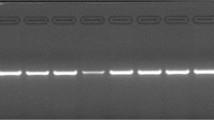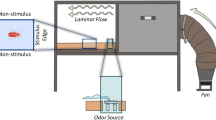Abstract
Migration and gene flow of natural enemies play an important role in the stability of predator-prey interactions and community organization in both natural and managed systems. Yet, relative to that of their herbivorous insect prey, the genetic structure of natural enemy populations has been little studied. We present evidence that populations of the predatory coccinellid beetle Coleomegilla maculata (Coleoptera: Coccinellidae), are not genetically subdivided and that levels of gene flow among these populations are extremely high. Furthermore, in the same geographical area, gene flow of C. maculata was significantly (one order of magnitude) greater than that of an abundant prey species, the Colorado potato beetle Leptinotarsa decemlineata (Coleoptera: Chrysomelidae). The high mobility of this natural enemy relative to the insect herbivores on which it feeds may contribute to its effectiveness as a biological control agent in agricultural systems.
Similar content being viewed by others
Article PDF
References
Angalet, G W, Tropp, J M, and Eggert, A N. 1979. Coccinelld septempunctata in the United States: recolonization and notes on its ecology. Environ Entomol, 8, 896–901.
Atallah, Y H, and Newsom, L D. 1966. Ecological and nutritional studies on Coleomegilla maculata De Geer (Coleoptera: Coccinellidae). I. The development of an artificial diet and a laboratory rearing technique. J Econ Entomol, 59, 1173–1180.
Birky, C W, Fuerst, P, and Maruyama, T. 1989. Organelle gene diversity under migration, mutation and drift: equilibrium expectations, approach to equilibrium, effects of heteroplasmic cells and comparison of nuclear genes. Genetics, 121, 613–627.
Butlin, R K. 1990. Divergence in emergence time of host races due to differential gene flow. Heredity, 65, 47–50.
Caprio, M A, and Tabashnik, B E. 1992a. Allozymes used to estimate gene flow among populations of diamondback moth (Lepidoptera: Plutellidae) in Hawaii. Environ Entomol, 21, 808–816.
Caprio, M A, and Tabashnik, B E. 1992b. Gene flow accelerates local adaptation among finite populations: simulating the evolution of insecticide resistance. J Econ Entomol, 85, 611–620.
Chakraborty, R, and Leimar, O. 1987. Genetic variation within a subdivided population. In: Ryman, N. and Utter, F. (eds) Population Genetics and Fisheries Management. pp. 80–120. University of Washington Press, Seattle, Washington.
Coll, M. 1991. Effects of vegetation texture on the Mexican bean beetle and its parasitoid, Pediobius foveolatus. Ph.D. Dissertation. University of Maryland.
Coll, M, and Bottrell, D G. 1991. Microhabitat and resource selection of the European corn borer (Lepidoptera: Pyralidae) and its natural enemies in Maryland field corn. Environ Entomol, 20, 526–533.
Comins, H N. 1977. The development of insecticide resistance in the presence of migration. J Theor Biol, 64, 177–197.
Cosper, R D, Gaylor, M J, and Williams, J C. 1983. Intraplant distribution of three insect predators on cotton and seasonal effects of their distribution on vacuum sampler efficiency. Environ Entomol, 12, 1568–1571.
Croft, B A, and Brown, A W A. 1975. Response of arthropod natural enemies to insecticides. Ann Rev Entomol, 20, 285–355.
Crow, J F. 1986. Basic Concepts in Population, Quantitative and Evolutionary Genetics. W. H. Freeman, New York.
Crow, J F, and Aoki, K. 1984. Group selection for a polygenic behavioral trait: estimating the degree of population subdivision. Proc Natl Acad Sci USA, 81, 6073–6077.
Crowley, P H. 1992. Resampling methods for computation-intensive data analysis in ecology and evolution. Ann Rev Ecol Syst, 23, 405–447.
Daly, J C. 1989. The use of electrophoretic data in a study of gene flow in the pest species Heliothis armigera (Hübner) and H. punctigera Wallengren (Lepidoptera: Noctuidae). In: Loxdale, H. D. and Den Hollander, J. (eds) Electrophoretic Studies on Agricultural Pests, pp. 115–141. Clarendon Press, Oxford.
Ehrlich, P R, and Raven, P H. 1969. Differentiation of populations. Science, 165, 1228–1232.
Elsey, K D. 1974. Influence of plant host on searching speed of two predators. Entomophaga, 19, 197.
Endler, J A. 1979. Gene flow and life history patterns. Genetics, 93, 263–284.
Ewert, M A, and Chiang, H C. 1966. Dispersal of three species of coccinellids in corn fields. Can Era, 98, 999–1003.
Georghiou, G P. 1972. The evolution of resistance to pesticides. Ann Rev Ecol Syst, 3, 133–168.
Georghiou, G P, and Taylor, C E. 1977. Genetic and biological influences in the evolution of insecticide resistance. J Econ Entomol, 7, 319–323.
Gordon, H T. 1961. Nutritional factors in insect resistance to chemicals. Ann Rev Entomol, 6, 27–54.
Graves, J B, Mohamad, R B, and Clower, D F. 1978. Beneficial insects [Coleomegilla maculata, Caocoria punatipes, Onus insidiscus] also developing ‘resistance’ [Biological control with insect predators and parasites]. La-Agric, 22, 11–12.
Groden, E, Drummond, F A, Casagrande, R A, and Haynes, D L. 1990. Coleomegilla maculata (Coleoptera: Coccinellidae): its predation upon the Colorado potato beetle (Coleoptera: Chrysomelidae) and its incidence in potatoes and surrounding crops. J Econ Entomol, 83, 1306–1315.
Hagen, K S. 1962. Biology and ecology of predacious coccinellidae. Ann Rev Entomol, 7, 289–326.
Hassell, M P. 1978. The Dynamics of Arthropod Predator-Prey Systems. Princeton University Press, Princeton, New Jersey.
Hassell, M P, and May, R M. 1988. Spatial heterogeneity and the dynamics of parasitoid-host systems. Ann Zoo Fennici, 25, 55–61.
Hazzard, R V, and Ferro, D N. 1991. Feeding responses of adult Coleomegilla maculata (Coleoptera: Coccinellidae) to eggs of Colorado potato beetle (Coleoptera: Chrysomelidae) and green peach aphids (Homoptera: Aphididae). Environ Entomol, 20, 644–651.
Hazzard, R V, Ferro, D N, Van Drieshe, R G, and Tuttle, A F. 1991. Mortality of eggs of Colorado potato beetle (Coleoptera: Chrysomelidae) from predation by Coleomegilla maculata (Coleoptera: Coccinellidae). Environ Entomol, 20, 841–848.
Head, R, Neel, W W, Sartor, C F, and Chambers, H. 1977. Methyl parathion and carbaryl resistance in Chrysomela scripta and Coleomegilla maculata. Bull Env Contam Tox, 17, 163–164.
Hebert, P D N, and Beaton, M J. 1989. Methodologies for Allozyme Analysis Using Cellulose Acetate Electrophoresis. Helena Laboratories, Beaumont Texas.
Hodek, I. 1973. Biology of Coccinellidae. Academia, Prague.
Hsiao, T H. 1989. Estimation of genetic variability amongst Coleoptera. In: Loxdale, H. D. and den Hollander, J. (eds) Electrophoretic Studies on Agricultural Pests, pp. 143–180. Clarendon Press, Oxford.
Huffaker, C B. 1971. The ecology of pesticide interference with insect populations. In: Swift, J. E. (ed.) Agricultural Chemicals—Harmony or Discord for Food, People and the Environment, pp. 92–107. University of California, Berkeley, California.
Kimura, M. 1983. The Neutral Theory of Evolution. Cambridge University Press, Cambridge.
Krafsur, E S, Obrycki, J J, and Flanders, R V. 1992. Gene flow in populations of the seven-spotted lady beetle, Coccinella septempunctata. J Hered, 83, 440–444.
Loxdale, H D, and Den Hollander, J. (eds) 1989. Electrophoretic Studies on Agricultural Pests. Clarendon Press, Oxford.
Mantel, N. 1967. The detection of disease clustering and a generalized regression approach. Cancer Res, 27, 209–220.
Marck, T P, and Smilowitz, Z. 1982. CMACSIM, a temperature-dependent predator-prey model simulating the impact of Coleomegilla maculata (De Geer) on green peach aphids on potato plants. Environ Entomol, 11, 1193–1201.
McCauley, D E. 1991. Genetic consequences of local population extinction and recolonization. Trends Ecol Evol, 6, 5–8.
McCauley, D E, and Eanes, W F. 1987. Hierarchical population structure analysis of the milkweed beetle, Tetraopes tetraophthalmus (Forster). Heredity, 58, 193–201.
Murdoch, W W, Chesson, J, and Chesson, P. 1985. Biological control in theory and practice. AM Nat, 125, 344–366.
Nei, M. 1973. Analysis of gene diversity in subdivided populations. Proc Nad Acad Sci USA, 70, 3321–3323.
Nei, M. 1977. F-statistics and analysis of gene diversity in subdivided populations. Ann Hum Genet, 41, 225–233.
Obrycki, J J, and Tauber, M J. 1978. Thermal requirements for development of Coleomegilla maculata (Coleoptera: Coccinellidae) and its parasite Perilitus coccinellae (Hymenoptera: Braconidae). Can Ent, 110, 407–412.
Pashley, D P, Johnson, S J, and Sparks, A N. 1985. Genetic population structure of migratory moths: the fall army-worm (Lepidoptera: Noctuidae). Ann Entomol Soc Am, 78, 756–762.
Richardson, B J, Baverstock, P R, and Adams, M. 1986. Allozyme Electrophoresis. Academic Press, New York.
Richardson, J V, and Deloach, C J. 1973. Seasonal abundance of Perilitus coccinellae and its coccinellid hosts and degree of parasitism in Central Missouri. Environ Entomol, 2, 138–141.
Roderick, G K. 1992. Post-colonization evolution of natural enemies. In: Kauffman, W. C. and Nechols, J. R. (eds) Selection Criteria and Ecological Consequences of Importing Natural Enemies Thomas Say Publ of Entomological Society of America, 1, 71–86.
Roderick, G K. 1993. Genetics of host plant adaptation in planthoppers (Homoptera: Delphacidae). In: Denno, R. F. and Perfect, J. (eds) Planthoppers: Their Ecology, Genetics and Management, pp. 257–281. Chapman and Hall, New-York.
Roderick, G K, and Caldwell, R L. 1992. An entomological perspective on animal dispersal. In: Stenseth, N. C. and Lidicker, W. Z. (eds) Animal Migration, pp. 274–290. Chapman and Hall, New York.
Rosenheim, J A, and Hoy, M A. 1986. Intraspecific variation in levels of pesticide resistance in field populations of a para-sitoid, Aphytis melinus (Hymenoptera: Aphelinidae): the role of past selection pressures. J Econ Entomol, 19, 1161–1173.
Rosenheim, J A, and Tabashnik, B E. 1991. Influence of generation time on the rate of response to selection. Am Nat, 137, 527–541.
SAS Institute. 1985. SAS User's Guide: Statistics, version 5. Cary, North Carolina.
Slatkin, M. 1985a. Gene flow in natural populations. Ann Rev Ecol Syst, 16, 393–430.
Slatkin, M. 1985b. Rare alleles as indicators of gene flow. Evolution, 39, 53–65.
Slatkin, M. 1987. Gene flow and geographic structure of natural populations. Science, 236, 787–792.
Slatkin, M, and Barton, N H. 1989. A comparison of three indirect methods for estimating average levels of gene flow. Evolution, 43, 1349–1368.
Smith, B C. 1960. A technique for rearing coccinellid beetles on dry foods and influence of various pollens on the development of Coleomegilla maculata Lengi Timb. (Coleoptera: Coccinellidae). Can J Zool, 38, 1047–1049.
Sokal, R R, and Rohlf, F J. 1981. Biometry, 2nd edn. W.H. Freeman and Co., New York.
Steiner, W W M, and Grasela, J J. 1993. Population genetics and gene variation in the predator, Coleomegilla maculata (De Geer) (Coleoptera: Coccinellidae). Ann Entomol Soc Am, 86, 309–321.
Strong, D R. 1988. Parasitoid theory: from aggregation to dispersal. Trends Ecol Evol, 3, 277–280.
Swofford, D L, and Selander, R B. 1981. Biosys-1: a Fortran program for the comprehensive analysis of electrophoretic data in population genetics and systematics. J Hered, 72, 281–283.
Tabashnik, B E. 1986. Evolution of pesticide resistance in predator/prey systems. Bull Entomol Soc Am, 32, 156–161.
Tabashnik, B E, and Croft, B A. 1982. Managing pesticide resistance in crop-arthropod complexes: interactions between biological and operation factors. Environ Entomol, 11, 1137–1144.
Takahata, N. 1983. Gene identity and genetic differentiation of populations in the finite island model. Genetics, 104, 497–512.
Takahata, N, and Nei, M. 1984. FST and GST statistics in the finite island model. Genetics, 107, 501–504.
Taylor, A D. 1991. Studying metapopulation effects in predator prey systems. Biol J Linn Soc, 42, 305–323.
Taylor, C E, and Georghiou, G P. 1979. Suppression of insecticide resistance by alteration of gene domination and migration. J Econ Entomol, 72, 105–109.
Warren, L O, and Tadic, M. 1967. Biological observations on Coleomegilla maculata and its role as a predator of the fall webworm. J Econ Entomol, 60, 1492–1496.
Weir, B S. 1990. Genetic Data Analysis. Sinauer Associates, Sunderland, MA.
Weir, B S, and Cockerham, C C. 1984. Estimating F-statistics for the analysis of population structure. Evolution, 38, 1358–1370.
Wright, S. 1931. Evolution in Mendelian populations. Genetics, 16, 97–159.
Wright, S. 1943. Isolation by distance. Genetics, 16, 114–138.
Wright, S. 1951. The genetical structure of populations. Ann Eugen, 15, 323–354.
Wright, S. 1978. Evolution and the Genetics of Populations, vol. 4. Variability Within and Among Natural Populations. University of Chicago Press, Chicago.
Wright, E J, and Laing, J E. 1980. Numerical response of coccinellids to aphids in corn in southern Ontario. Can Ent, 112, 977–988.
Author information
Authors and Affiliations
Rights and permissions
About this article
Cite this article
Coll, M., Garcia De Mendoza, L. & Roderick, G. Population structure of a predatory beetle: the importance of gene flow for intertrophic level interactions. Heredity 72, 228–236 (1994). https://doi.org/10.1038/hdy.1994.32
Received:
Issue date:
DOI: https://doi.org/10.1038/hdy.1994.32



